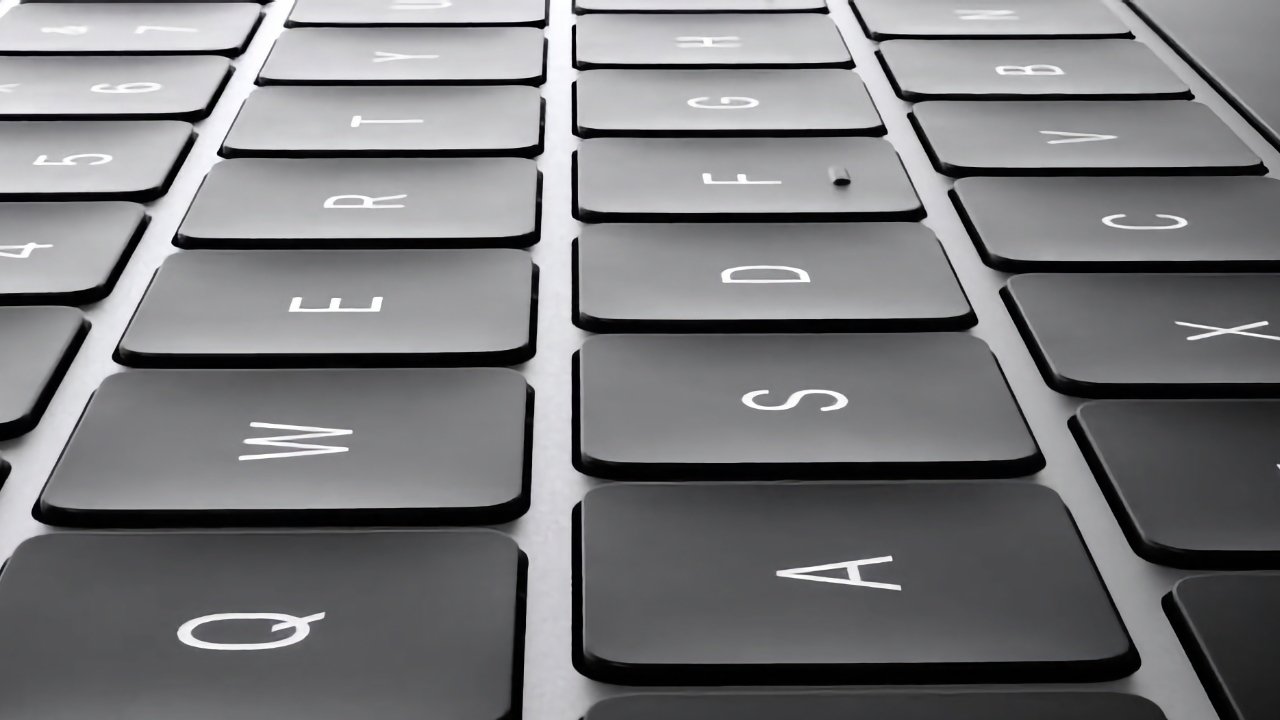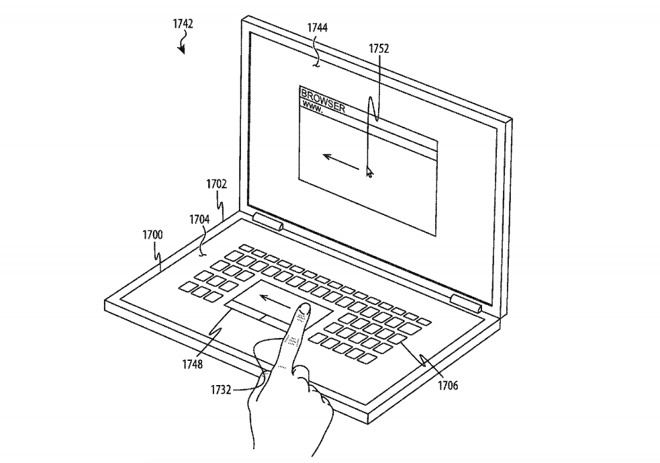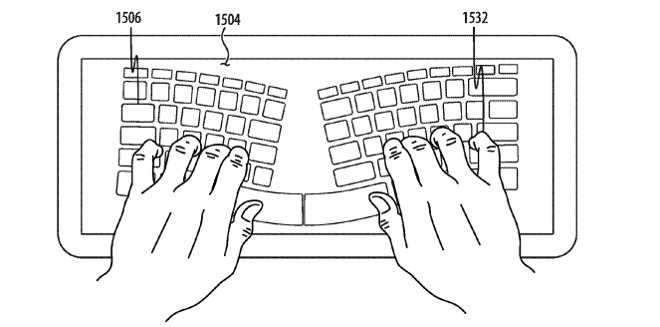Future MacBook Pro might have solid state keyboard, like its trackpad
Apple has been awarded a patent for a "Keyless keyboard," which shows the company is at least considering moving to using solid state technologies to create a MacBook Pro keyboard with more versatility than a physical version can ever provide.

The newly granted patent, "Keyless keyboard with force sensing and haptic feedback," was originally filed with the U.S. Patent and Trademark Office in 2017. It effectively describes replacing the physical keys of a keyboard with a glass display equipped with multiple touch sensing systems.
Apple's application claims traditional key-based inputs "lack the flexibility to accommodate expansive features offered by newer devices, operating systems, and software," and are "unable to adapt to different user needs and preferences." While touchscreen inputs have the potential for offering alternative inputs to the user, the "flat, inflexible input surface" provides little or no tactile feedback to the user.

Apple's proposal consists of a top glass layer that includes two force sensing systems for different "input regions," as well as a touch sensing system for determining the location of the user's fingers. Haptic feedback is provided by one or more actuators, to provide a response for each key "press."
Images supplied in the filing depict a keyboard peripheral that uses a long touch panel where the key images appear. There is also a depiction of a notebook that seems to have the entire lower section, typically reserved for the keyboard and the trackpad, replaced by a single large panel.
In both cases, the keyless keyboard changes what is shown depending on the user's need. This can include showing a trackpad area in the middle of the keyboard, and rearranging the layout to one that is more ergonomic for the user's hand positioning.

As a byproduct, the use of a software-defined keyboard layout opens up the possibility of simplifying localization of Apple's hardware, as the same keyboard could be used for any language. The flexibility could also allow for unique inputs for specific apps that are not keyboard related, such as sliders or other types of controls.
Apple has looked into other ways for its customers to use future MacBooks without using a physical keyboard. In 2018, for instance, it received a patent for "Dual display equipment with enhanced visibility and suppressed reflections," where the second screen is used as a dynamic keyboard.
The concept is also not limited to dual-display devices, as another patent application was discovered in October 2017 detailing "Electronic Devices with Displays" that could be folded in half. A flexible portion in the middle of the display would allow it to fold, effectively allowing an iPad-style device to be shaped similar to a notebook, with the software keyboard residing on one of the two flat sections.
Apple is known for filing large numbers of patent applications for potential products, many of which do not end up being used in consumer products. While it is possible Apple could implement such a keyless keyboard system in a future product, it remains too early to tell if it will happen.
Read on AppleInsider

The newly granted patent, "Keyless keyboard with force sensing and haptic feedback," was originally filed with the U.S. Patent and Trademark Office in 2017. It effectively describes replacing the physical keys of a keyboard with a glass display equipped with multiple touch sensing systems.
Apple's application claims traditional key-based inputs "lack the flexibility to accommodate expansive features offered by newer devices, operating systems, and software," and are "unable to adapt to different user needs and preferences." While touchscreen inputs have the potential for offering alternative inputs to the user, the "flat, inflexible input surface" provides little or no tactile feedback to the user.

Apple's proposal consists of a top glass layer that includes two force sensing systems for different "input regions," as well as a touch sensing system for determining the location of the user's fingers. Haptic feedback is provided by one or more actuators, to provide a response for each key "press."
Images supplied in the filing depict a keyboard peripheral that uses a long touch panel where the key images appear. There is also a depiction of a notebook that seems to have the entire lower section, typically reserved for the keyboard and the trackpad, replaced by a single large panel.
In both cases, the keyless keyboard changes what is shown depending on the user's need. This can include showing a trackpad area in the middle of the keyboard, and rearranging the layout to one that is more ergonomic for the user's hand positioning.

As a byproduct, the use of a software-defined keyboard layout opens up the possibility of simplifying localization of Apple's hardware, as the same keyboard could be used for any language. The flexibility could also allow for unique inputs for specific apps that are not keyboard related, such as sliders or other types of controls.
Apple has looked into other ways for its customers to use future MacBooks without using a physical keyboard. In 2018, for instance, it received a patent for "Dual display equipment with enhanced visibility and suppressed reflections," where the second screen is used as a dynamic keyboard.
The concept is also not limited to dual-display devices, as another patent application was discovered in October 2017 detailing "Electronic Devices with Displays" that could be folded in half. A flexible portion in the middle of the display would allow it to fold, effectively allowing an iPad-style device to be shaped similar to a notebook, with the software keyboard residing on one of the two flat sections.
Apple is known for filing large numbers of patent applications for potential products, many of which do not end up being used in consumer products. While it is possible Apple could implement such a keyless keyboard system in a future product, it remains too early to tell if it will happen.
Read on AppleInsider

Comments
https://arstechnica.com/gadgets/2016/12/lenovo-yoga-book-review-a-keyless-keyboard-that-will-get-you-talking-not-typing/
Asus had a dual screen clamshell concept laptop before this. Obviously the Nintendo DS. And I’m sure many an OEM, big and small including Apple, has had variants of this idea through the last couple of decades.
Apple’s got most of the hardware and software available to them though. Taptic engines or force touch haptics, low latency high refresh rate displays, SoCs, stylus, and tens of thousands of apps that could run on it already. The integration for a complete product is a lot of work still. I remain convinced that this type of form factor will be great for students, engineers, and any workflow that requires taking notes or drawing input. So, I think there is a market there. And, I definitely think a virtual keyboard could be designed to be just as productive or more so than a hardware based one.
I’m definitely thinking Apple is just going to put an iPad like display - and SoC, iOS - where the keyboard is on a clamshell form factor. Basically, an iPad sized Touch Bar with a Taptic Engine attached. Whether it is macOS or iOS running the vertical display, who knows, I just hope it has macOS level features.
A “key” would need to know when your finger is resting on it and then generate a “shaped” haptic: shallow near the edges then deeper towards the centre. The F and J keys would need a different shape to identify them.
Sounds tricky.
Please spare us a disaster like, or worse than, the keyboard on the 2016 15-in MacBook Pro!
It's a pity it's so susceptible to crumbs (always been easily removed by compressed air on this machine), but it's an utter joy to type on.
on a touchscreen-only device, a solid state keyboard is fine, but even then, they make keyboards for iPads for a reason.